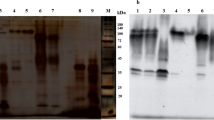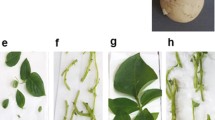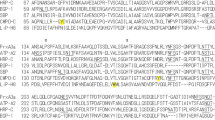Abstract
Two peroxidases, cPOD-I and rPOD-II, have been isolated and purified from cotton cell suspension and their biochemical characteristics studied. rPOD-II from R405-2000, a non-embryogenic cultivar, has higher activity than cPOD-I derived from Coker 312, which developed an embryogenic structure. The cPOD-I and rPOD-II had molecular mass of 39.1 and 64 kDa respectively, as determined by SDS-PAGE. Both enzymes showed high efficiency of interaction with the guaiacol at 25 mM. The optimal pH for cPOD-I and rPOD-II activity was 5.0 and 6.0, respectively. The enzyme had an optimum temperature of 25 °C and was relatively stable at 20–30 °C. The isoenzymes were highly inhibited by ascorbic acid, dithiothreitol, sodium metabisulfite, and β-mercaptoethanol. Their activities were highly enhanced by Al3+, Fe3+, Ca2+, and Ni2+, but they were moderately inhibited by Mn2+ and K+. The enzyme lost 50% to 62% of its activity in the presence of Zn2+ and Hg2+.








Similar content being viewed by others
References
Kay, E., Leland, M., & Jow, Y. (1967). Peroxidase isoenzymes from horseradish roots. The Journal of Biological Chemistry, 242, 2470–2473.
Castillo, L., Alpeeva, I., Chubar, T., Galaev, I., Csoregi, E., & Sakharov, I. (2002). Purification and substrate of peroxidase from sweet potato tubers. Plant Science, 163, 1011–1019.
Deepa, S., & Arumughan, C. (2002). Purification and characterization of soluble peroxidase from oil palm (Elaeis guinensis Jacq.) leaf. Phytochemistry, 61, 503–511. doi:10.1016/S0031-9422(02)00167-X
Thongsook, T., & Barrett, M. (2005). Purification and partial characterization of broccoli (Brassica oleracea var. Italica) peroxidases. Journal of Agricultural and Food Chemistry, 53, 3206–3214. doi:10.1021/jf048162s
Brownleader, M., Ahmed, N., Trevan, M., Chaplin, M., & Prakash, M. (1995). Purification and partial characterization of tomato extension peroxidase. Plant Physiology, 109, 1115–1123.
Bernards, M. A., Fleming, W. D., Llewellyn, D. B., Priefer, R., Yang, X., Sabatino, A., et al. (1999). Biochemical characterization of the suberization-associated anionic peroxidase of potato. Plant Physiology, 121, 135–145. doi:10.1104/pp.121.1.135
Christensen, J. H., Bauw, G., Welinder, K. G., Van Montagu, M., & Boerjan, W. (1998). Purification and characterization of peroxidases correlated with lignification in poplar xylem. Plant Physiology, 118, 125–135. doi:10.1104/pp.118.1.125
Kawano, T. (2003). Roles of the reactive oxygen species-generating peroxidase reactions in plant defense and growth induction. Plant Cell Reports, 21, 829–837.
Morales, M., Pedreno, M. A., Munoz, R., Rosbarcelo, A., & Calderon, A. (1993). Purification and kinetic characterization of a basic peroxidase isoenzyme responsible for lignification in Gamay rouge grape (Vities vinifera) berries. Food Chemistry, 48, 391–394. doi:10.1016/0308-8146(93)90323-8
Passardi, F., Cosio, C., Penel, C., & Dunand, C. (2005). Peroxidases have more functions than a Swiss army knife. Plant Cell Reports, 24, 255–265. doi:10.1007/s00299-005-0972-6
Zhang, B. H., Feng, R., Liu, F., & Wang, Q. (2001). High frequency somatic embryogenesis and plant regeneration of an elite Chinese cotton variety. Botanical Bulletin of Academia Sinica, 42, 9–16.
Sément, G. (1986). In Maisonneuve et Larose (Ed.), Le cotonnier en Afrique tropicale. Paris, p. 133.
Finer, J. J., & McMullen, M. D. (1990). Transformation of cotton (Gossypium hirsutum L.) via particle bombardment. Plant Cell Reports, 8, 586–589. doi:10.1007/BF00270059
Shoemaker, R. C., Couche, I. J., & Galbraith, D. W. (1986). Characterization of somatic embryogenesis and plant regeneration in cotton (Gossypium hirsutum L.). Plant Cell Reports, 3, 178–181. doi:10.1007/BF00269112
Trolinder, N. L., & Xhixian, C. (1989). Genotype specificity of the somatic embryogenesis response in cotton. Plant Cell Reports, 8, 133–136. doi:10.1007/BF00716824
Joersbo, M., Andersen, J. M., Okkels, F. T., & Rajagopal, R. (1989). Isoperoxidases as markers of embryogenesis in carrot cell suspension cultures. Physiologia Plantarum, 76, 10–14. doi:10.1111/j.1399-3054.1989.tb05445.x
Zhou, X., Han, Y., Yang, W., & Xi, T. (1992). Somatic embryogenesis and analysis of peroxidase in culture lettuce (Latuca sativa L.) cotyledons. Annals of Botany, 69, 97–101.
Kouakou, T. H., Kouadio, Y. J., Koné, M., Zouzou, M., & Anno, A. P. (2004). Evolution des composés phénoliques au cours de la callogenèse et de la culture de suspensions cellulaires chez Gossypium hirsutum L. Biot. Rev. Int. Sci. Vie Terre, 4(1), 143–151.
Kouakou, T. H., Waffo, T. P., Kouadio, Y. J., Valls, J., Tristan, R., Decendit, A., et al. (2007). Phenolic compounds and somatic embryogenesis in cotton (Gossypium hirsutum L.). Plant Cell, Tissue and Organ Culture, 90, 25–29. doi:10.1007/s11240-007-9243-2
Kouakou, T. H. (2003) Contribution à l’étude de l’embryogenèse somatique du cotonnier (Gossypium hirsutum L.): évolution de quelques paramètres biochimiques au cours de la callogenèse et de culture de suspensions cellulaires chez trois cultivars (Coker 312, ISA 205N et ISA GL7). Ph.D. Dissertation, University of Cocody, Abidjan, Côte d’Ivoire.
Zouine, J., & El hadrami, i. (2004). Somatic embryogenesis in Phoenix dactylifera L.: Effect of exogenous supply of sucrose on proteins, sugar, phenolics and peroxidases activities during the embryogenic cell suspension culture. Biotechnology, 3(2), 114–118.
Kouakou, T. H., Waffo, T. P., Kouadio, Y. J., Valls, J., Decendit, A., & Merillon, J. M. (2006). First evidence of trans-resveratrol production in cell suspension cultures of cotton. Plant Cell, Tissue and Organ Culture, 86, 405–409. doi:10.1007/s11240-006-9136-9
Murashige, T., & Skoog, F. (1962). A revised medium for rapid growth and bioassays with tobacco tissue cultures. Physiologia Plantarum, 15, 473–497. doi:10.1111/j.1399-3054.1962.tb08052.x
Gamborg, O. L., Miller, R. A., & Ojima, K. (1968). Nutrient requirements of suspension cultures of soybean root cells. Experimental Cell Research, 50, 151–158. doi:10.1016/0014-4827(68)90403-5
Rompel, A., Albers, M., Naseri, J. I., Gerdemann, C., Büldt-Karentzopoulos, K., Jasper, B., et al. (2007). Purification, cloning and characterization of a novel peroxidase isozyme from sweet potatoes (Ipomoea batatas). Biochimica et Biophysica Acta, 1774, 1422–1430. doi:10.1016/j.bbapap.2007.08.013
Laemmli, U. K. (1970). Cleavage of structural proteins during the assembly of the head Bacteiofage T4. Nature, 227, 680–685. doi:10.1038/227680a0
Zhou, P., Smith, N. L., & Lee, C. Y. (1993). Potential purification and some properties of Monroe apple peel polyphenol oxidase. Journal of Agricultural and Food Chemistry, 41(4), 1446–1449.
Kassem, M. A., & Jacquin, A. (2001). Somatic embryogenesis, rhizogenesis, and morphinan alkaloids production in two species of opium poppy. Journal of Biomedicine & Biotechnology, 1(2), 70–78. doi:10.1155/S1110724301000237
Thiruvengadam, M., Varisai, S. M., yang, C. H., & Jayabalan, N. (2006). Development of an embryogenic culture of bitter melon (Momordica charantia L.). Scientia Horticulturae, 109, 123–129. doi:10.1016/j.scienta.2006.03.012
Davidonis, G. H., & Hamilton, R. H. (1983). Plant regeneration from Callus tissue of Gossypium klotzchianum L. Plant Science Letters, 32, 89–93. doi:10.1016/0304-4211(83)90102-5
Ragan, T. S., Zvala, T., & Ip, A. (1984). Somatic embryogenesis in Gossypium hirsutum L. In Vitro ab, 20, 256–259.
Kumria, R., Sunnichan, V. G., Das, D. K., Gupta, S. K., Reddy, V. S., Bhatnagar, R. K., et al. (2003). High-frequency somatic embryo production and maturation into normal plants in cotton (Gossypium hirsutum) through metabolic stress. Plant Cell Reports, 21, 635–639.
Trolinder, N. L., & Goodin, J. R. (1988). Somatic embryogenesis in cotton (G. hirsutum L). II-requirements for embryo development and plant regeneration. Plant Cell, Tissue and Organ Culture, 12, 43–53. doi:10.1007/BF00043106
Kouadio, Y. J., Koné, M., Djè, Y., d’Almeida, M. A., & Zouzou, M. (2004). L’étiolement est un facteur d’induction de l’embryogenèse somatique au cours de la callogenèse chez deux variétés récalcitrantes de cotonnier (Gossypium hirsutum L.) cultivées en Côte d’Ivoire. Biotechnologie, Agronomie, SocieÂte et environnemen, 8, 155–162.
Sun, Y., Zhang, X., Huang, C., Guo, X., & Nie, Y. (2006). Somatic embryogenesis and plant regeneration from different wild diploid cotton (Gossypium) species. Plant Cell Reports, 25(4), 289–296. doi:10.1007/s00299-005-0085-2
Wu, J., Zhang, X., Nie, Y., Jin, S., & Liang, S. (2004). Factor affecting somatic embryogenesis and plant regeneration from a range of recalcitrant genotypes of Chinese cottons (Gossypium hirsutum L.). In Vitro Cellular & Developmental Biology, 40, 371–377.
Xie, D. Y., Jin, S. X., Guo, X. P., & Zhang, X. L. (2007). Somatic embryogenesis and plant regeneration in Cotton cultivars from yellow and Yangtze River planting areas. Acta Agronomica Sinica, 33(3), 394–400.
Loomis, W. D. (1974). Overcoming problems of phenolics and quinones in the isolation of plant enzymes and organelles. Methods in Enzymology, 31, 528–540. doi:10.1016/0076-6879(74)31057-9
Bordier, C. (1981). Phase separation of integral membrane proteins in Triton X-114 solution. The Journal of Biological Chemistry, 256(4), 1604–1607.
Nunez-Delicado, E., Sojo, M. M., Garcıa-Carmona, F., & a Sanchez-Ferrer, A. (2003). Partial purification of latent persimmon fruit polyphenoloxidase. Journal of Agricultural and Food Chemistry, 51, 2058–2063. doi:10.1021/jf0208583
Sanchez-Ferrer, A., Laveda, F., & Garcıa-Carmona, F. (1993). Partial purification of soluble potato polyphenol oxidase by partitioning in an aqueous two-phase system. Journal of Agricultural and Food Chemistry, 41, 1583–1586. doi:10.1021/jf00034a010
Sanchez-Ferrer, A., Bru, R., & Garcıa-Carmona, F. (1989). Novel procedure for extraction of a latent grape polyphenol oxidase using temperature-induced phase separation in Triton X-114. Plant Physiology, 91, 1481–1487.
Duarte-Vazquez, M. A., Garcia-Almendarez, B., Regalado, C., & Whitaker, J. R. (2000). Purification and partial characterization of three turnip (Brassica napus L) peroxidases. Journal of Agricultural and Food Chemistry, 48, 1574–1579. doi:10.1021/jf990454j
Kvaratskhelia, M., Winkel, C., & Thorneley, R. N. (1997). Purification and characterization of a novel class III peroxidase isoenzyme from tea leaves. Plant Physiology, 114, 1237–1245. doi:10.1104/pp.114.4.1237
Vamos-Vigyazo, L. (1981). Polyphenol oxidase and peroxidase in fruits and vegetables. CRC Critical Reviews in Food Science and Nutrition, 15, 49–127.
Belitz, H. D., & Grosch, W.(1999). In H. Belitz, & W. Grosch (eds.), Enzymes, vol. 21: Food chemistry (pp. 92–139). Heidelberg, Washington, USA: Springer.
Robinson, D. S. (1991) In D. Robinson, & N. A. Eskin (Eds.), Peroxidases and catalases in foods, vol. 1: Oxidative enzymes in food (pp. 1–37). London & New York: Elsevier Applied Science.
Lee, M., & Kim, S. (1994). Characteristics of six isoperoxidases from Korean radish roots. Phytochemistry, 35, 287–290. doi:10.1016/S0031-9422(00)94749-6
Ravindra, N., & Van-Huystee, R. (1984). Characterization of peroxidase in plant cells. Plant Physiology, 75, 956–958.
Forsyth, J. L., & Robinson, D. S. (1998). Purification of Brussels sprouts isoperoxidases. Food Chemistry, 63(2), 227–234. doi:10.1016/S0308-8146(97)00242-2
Converso, D. A., & Fernandez, M. E. (1995). Peroxidase isozymes from wheat germ: Purification and properties. Phytochemistry, 40, 1341–1346. doi:10.1016/0031-9422(95)00366-F
Boucoiran, C. F., Kijne, J. W., & Recourt, K. (2000). Isolation and partial characterization of thermostable peroxidases from potato (Solanum tubarosum L.) tuber sprouts. Journal of Agricultural and Food Chemistry, 48, 701–707. doi:10.1021/jf981352g
Lin, Z., Chen, L., & Zhang, W. (1996). Peroxidase from Ipomoea cairica (L) SW. Isolation, purification and some properties. Process Biochemistry, 31(5), 334–449.
Civello, P. M., Martinez, G. A., Chaves, A. R., & Anon, M. C. (1995). Peroxidase from strawberry fruit (Fragaria ananassa Duch.): Partial purification and determination of some properties. Journal of Agricultural and Food Chemistry, 43, 2596–25601. doi:10.1021/jf00058a008
Riquelme, A., & Cardemil, L. (1993). Peroxidases in the cell walls of seeds and seedlings of Araucaria araucana. Phytochemistry, 32(1), 15–20. doi:10.1016/0031-9422(92)80098-Y
Whitaker, J. R. (1994). In effect of pH on enzyme catalysed reactions, vol. 2: Principles of enzymology for the food science pp. 271–300. New York: Marcel Dekker.
Tang, W., & Newton, R. J. (2005). Peroxidase and catalase activities are involved in direct adventitious shoot formation induced by thidiazuron in eastern white pine (Pinus strobus L.) zygotic embryos. Plant Physiology and Biochemistry, 43, 760–769. doi:10.1016/j.plaphy.2005.05.008
Sakharov, I. Y., Vesga, M. K., Galaev, I., Sakharova, I. V., & Pletushkina, O. Y. (2001). Peroxidase from leaves of royal palm tree Roystonea regia: Purification and some properties. Journal of Plant Science, 161, 853–860. doi:10.1016/S0168-9452(01)00466-6
Richard-Forget, F. C., & Gauillard, F. A. (1997). Oxidation of chlorogenic acid, catechins, and 4-methylcatechol in model solutions by combinations of pear (Pyrus communis cv. Williams) polyphenol oxidase and peroxidase: A possible involvement of peroxidase in enzymatic browning. Journal of Agricultural and Food Chemistry, 45, 2472–2476. doi:10.1021/jf970042f
Agostini, E., Medina, M. I., Milrad, S. R., & Tiger, H. (1997). Properties of two anionic peroxidase isoenzymes from turnip (Brassica napus L.) root. Journal of Agricultural and Food Chemistry, 45, 596–598. doi:10.1021/jf960259u
Adams, J. B., Harvey, A., & Dempsey, C. E. (1996). Regenerated and denatured peroxidase as potential lipid oxidation catalysis. Food Chemistry, 57(4), 505–514. doi:10.1016/S0308-8146(96)00007-6
Qacif, N., Baaziz, M., & Bendiab, K. (2007). Biochemical investigations on peroxidase contents of male and female inflorescences of date palm (Phoenix dactylifera L.). Scientia Horticulturae, 114, 298–301. doi:10.1016/j.scienta.2007.07.015
Rudra, S. G., Shivhare, U. S., & Basu, S. (2008). Thermal inactivation kinetics of peroxidase in mint leaves. Journal of Food Engineering, 85, 147–153. doi:10.1016/j.jfoodeng.2007.07.010
Voet, D., & Voet, J. G. (1990). In Woolsey (Ed.), Mechanisms of enzyme action (pp. 344–347). New York: Wiley.
Billaud, C., Louarme, L., & Nicolas, J. (1999). Comparison of peroxidases from barley kernel (Hordeum vulgare L.) and wheat germ (Triticum aestivum L.): Isolation and preliminary characterization. Journal of Food Biochemistry, 23, 145–172. doi:10.1111/j.1745-4514.1999.tb00011.x
Serrano-Martınez, A., Fortea, M. I., del Amor, F. M., & Nunez-Delicado, E. (2008). Kinetic characterisation and thermal inactivation study of partially purified red pepper (Capsicum annuum L.) peroxidase. Food Chemistry, 107, 193–199. doi:10.1016/j.foodchem.2007.08.028
Mdluli, K. M. (2005). Partial purification and characterization of polyphenoloxidase and peroxidase from marula fruit (Scleorocarya birrea subsp. Caffra). Food Chemistry, 92, 311–323. doi:10.1016/j.foodchem.2004.07.026
Lopez, A., & Burgos, J. (1995). Peroxidase stability and reactivation after heat treatment and manotherosonication. Journal of Food Science, 60, 451–455. doi:10.1111/j.1365-2621.1995.tb09801.x
Segel, I. H. (1994). In: H. Segel (Ed.), Enzyme kinetic, behavior and analysis of rapid equilibrium and steady-state enzyme systems (pp. 100–136). Toronto, Canada: Wiley.
Dixon, M., & Webb, D. C.(1979). In D. Malcolm, E. Webb, C. Thorne, & K. Tipton (Eds.), Effect of pH, vol. 3: Enzymes (pp. 140–148). New York, USA: Longmans, Green Academic.
Kato, M., Aibara, S., Morita, Y., Nakatani, H., & Hiromi, K. (1984). Transient kinetics of peroxidase. Journal of Biochemistry, 95(3), 861–869.
Murakami, S., Takahara, H., & Shiraiwa, M. (2007). Purification and characterization of three neutral extracellular isoperoxidases from rye leaves. Phytochemistry, 68, 777–784. doi:10.1016/j.phytochem.2006.11.015
Ofelia M., Krzysztof N., Rosa M., Violeta, T. P. (2007). Purification and characterization of cell wall-bound peroxidase from vanilla bean. Food Science and Technology, doi:10.1016/j.lwt. 08.017.
Gerday, C., Aittaleb, M., Arpigny, J., Baise, E., Chessa, J., & Garsoux, G. (1997). Review. Psychrophilic enzymes: A thermodynamic challenge. Biochimica et Biophysica Acta, 1342, 119–131.
Anthon, G. E., & Barrett, D. M. (2002). Kinetic parameters for the thermal inactivation of quality-related enzymes in carrots and potatoes. Journal of Agricultural and Food Chemistry, 50, 4119–4125. doi:10.1021/jf011698i
Chisari, M., Barbagallo, R. N., & Spagna, G. (2007). Characterization of polyphenoloxidase and peroxidase and influence on browning of cold stores strawberry fruit. Journal of Agricultural and Food Chemistry, 55(9), 3469–3476. doi:10.1021/jf063402k
Debowska, R., & Podstolski, A. (2001). Properties of diphenolase from Vanilla planifolia (Andr.). Shoot primordia cultured in vitro. Journal of Agricultural and Food Chemistry, 49, 3432–3437. doi:10.1021/jf001180z
Mudd, J., & Burris, R. (1959). Participation of metals in peroxidase catalyzed oxidations. The Journal of Biological Chemistry, 234, 2774–2777.
Vallee, B., & Ulmer, D. (1972). Biological effects of mercury, cadmium and lead. Annual Review of Biochemistry, 49, 91–128. doi:10.1146/annurev.bi.41.070172.000515
Wong, D. W. (1995). In W. S. Dominic (Ed.), Horseradish peroxidase (pp. 321–345). New York: Champman and Hall.
Sanchez-Romera, C., Garcia-Gomez, M., Pliego-Alfaro, F., & Heredia, A. (1994). Effect of partial deglycosylation on catalytic characterization and stability of an avocado peroxidase. Physiologia Plantarum, 92, 97–101. doi:10.1111/j.1399-3054.1994.tb06660.x
Acknowledgments
The authors are grateful to CIRAD and CNRA for supplying cottonseeds. We thank Dr. Bognonkpe J.P. for its contribution.
Author information
Authors and Affiliations
Corresponding author
Rights and permissions
About this article
Cite this article
Kouakou, T.H., Dué, E.A., Kouadio, N.E.J.P. et al. Purification and Characterization of Cell Suspensions Peroxidase from Cotton (Gossypium hirsutum L.). Appl Biochem Biotechnol 157, 575–592 (2009). https://doi.org/10.1007/s12010-008-8287-z
Received:
Accepted:
Published:
Issue Date:
DOI: https://doi.org/10.1007/s12010-008-8287-z




